Posted on January 2, 2024 in ASRC News, Environmental Sciences Initiative, Nanoscience Initiative, Neuroscience Initiative, Photonics Initiative, Structural Biology Initiative

Every year, CUNY ASRC researchers challenge scientific limits and find the most creative ways to expand the world’s understanding of the Earth that we inhabit.
Here are 10 stories that offer a glimpse at some of the innovative work produced by our researchers. We hope these stories serve as motivation to pursue your goals and have a productive 2024. Happy New Year!
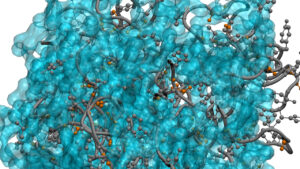
In a study, published in Angewandte Chemie, a chemistry journal from Wiley, ASRC researchers from the labs of Rein Ulijn, founding director of the CUNY ASRC Nanoscience Initiative and Einstein Professor of Chemistry at Hunter College, and Professor Shana Elbaum-Garfinkle honed a simple design to create their own sticky and flexible peptides that form liquid droplets.
Biological cells host a myriad of proteins that control several chemical processes that occur simultaneously. To avoid chaos, these processes need to be tightly regulated for cells to perform life’s essential tasks. In addition to presenting valuable insights on the regulation of cells, the team’s designer liquid bio-droplets have significant potential for use in biomedicine because the droplets are so readily observable under a microscope.

Using a thin layer of nano-patterned silicon, Andrea Alù, founding director of the CUNY ASRC Photonics Initiative and Distinguished Professor of Physics at the CUNY Graduate Center, and his lab designed a device that transmits light unidirectionally and prevents incoming reflections, without the use of bulky and expensive magnets. A recently published study in Nature Photonics details the successful experiment.
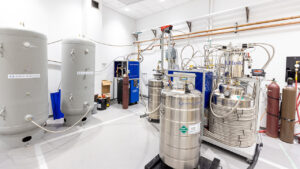
A helium recapture system used by the Graduate Center scientists since 2021 has saved thousands of dollars by recycling a dwindling natural resource. Supported by a grant from the National Institutes of Health (NIH), the system captures and recycles close to 90% of the helium used by five machines in the Nuclear Magnetic Resonance facilities at the CUNY ASRC and the City College Center for Discovery and Innovation. Kevin Gardner, founding director of the Structural Biology Initiative at the CUNY ASRC and Einstein Professor of Chemistry and Biochemistry, The City College of New York, authored the $170,000 NIH grant with former Research Associate Professor James Aramini.
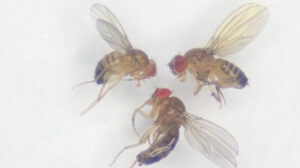
Can the common fruit fly help shed light on the functions of deep sleep? In a recent paper, published in the journal eLife, a team of neuroscientists from faculty researcher Orie Shafer’s lab at the CUNY ASRC Neuroscience Initiative found that when deprived of deep sleep, the fly attempted to recover it over the course of multiple sleep cycles, similarly to people.

The American residential lawn is, for many, an iconic landscape, and about half of homeowners in the U.S. use fertilizer to keep their yards green and lush. But those hallmarks of ostensive health hide a growing environmental health problem, which is caused when the nitrogen in fertilizers washes downstream or escapes into the atmosphere. A paper published in the journal Proceedings of the National Academy of Sciences (PNAS) NEXUS by CUNY ASRC Environmental Sciences Initiative researcher Peter Groffman and colleagues finds that fertilized lawns are hotspots of nitrogen export into our water and atmosphere.
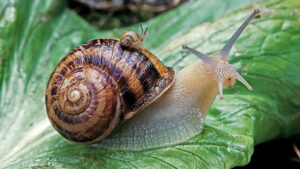
What is snail mucus? That was the question posed by researchers in a study that examines the molecular composition of snail mucus. When analyzing the mucus of a common garden snail, they found it contained a complex collection of proteins, some identified as entirely novel.
In a paper published in Nature Communications, scientists profile the mucus of Cornu aspersum — a species used in beauty product formulation and eaten as escargot — and detail the composition of three unique types of secretions — one that hydrates and protects its skin, another that works as a glue-like adhesive, and another that lubricates to allow the animal to move freely across surfaces. Lead author Antonio Cerullo, a biochemistry Ph.D. student at the CUNY Graduate Center, discussed the findings with NPR’s All Things Considered.
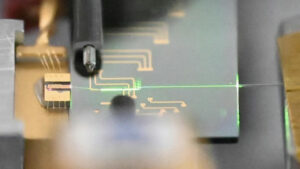
(Credit: Alireza Marandi)
Lasers are essential tools for observing, detecting, and measuring things in the natural world that we can’t see with the naked eye. But the ability to perform these tasks is often restricted by the need to use expensive and large instruments.
In a cover-story paper in the journal Science, researcher Qiushi Guo demonstrates a novel approach for creating high-performance ultrafast lasers on nanophotonic chips. His work centers on miniaturizing mode-lock lasers — a unique laser that emits a train of ultrashort, coherent light pulses in femtosecond intervals, which is an astonishing quadrillionth of a second.

More than 90% of clinical drug development efforts fail every year. A key factor driving the failure rate is that researchers currently have an imperfect method for determining early on whether and how small-molecule drug candidates bind to targeted disease-relevant proteins. A study by Daniel Keedy and a multi-institutional team of researchers published by the journal eLife could help finetune evaluation of small molecules, paving the way for new drug development.
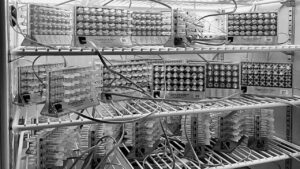
In a study published in the journal SLEEP, CUNY ASRC researchers set out to test a 40-year-old sleep cycle model in the common fruit fly. Their work is the first time the model, formulated by sleep researchers in the early 1980s, has been formally adapted and tested in fruit flies, said first author Lakshman Abhilash, a postdoctoral research associate with the CUNY ASRC Neuroscience Initiative. The team’s findings have possible implications for people with sleep phase disorders.

More than 25 million metric tons of plastic end up in the Earth’s soil every year, and how those plastics degrade can have major impact on the environment, plants, animals and humans. With the help of a $702,084 collaborative research grant from the National Science Foundation ($451,681 of which was awarded to the ASRC), a multi-institutional research team will address what is likely to be one of the major environmental problems of the 21st century: the effects of microplastics. The team includes project leader Brian Giebel, director of the ASRC Environmental Science Initiative’s Advanced Laboratory for Chemical and Isotopic Signatures, and professors Benjamin Bostick from Columbia University and Rich Gross from Rensselaer Polytechnic Institute.
